We had the most interesting conversation in PK3 last Monday. I read Snow on Snow on 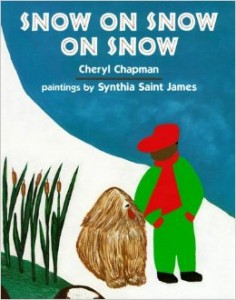 Snow by Cheryl Chapman and Synthia Saint James in both classes that day. It’s the story of a young boy who loses his dog while sledding. After some tense searching, he finds Clancy and the two joyfully reunite. When Clancy went missing, my students’ faces filled with concern. When Clancy emerged from a snow bank, they sighed and smiled, visibly relieved. It was easy to see that the children enjoyed the story. Why, then, did this book not receive a single vote in either class for Top Book?
Snow by Cheryl Chapman and Synthia Saint James in both classes that day. It’s the story of a young boy who loses his dog while sledding. After some tense searching, he finds Clancy and the two joyfully reunite. When Clancy went missing, my students’ faces filled with concern. When Clancy emerged from a snow bank, they sighed and smiled, visibly relieved. It was easy to see that the children enjoyed the story. Why, then, did this book not receive a single vote in either class for Top Book?
Sometimes my preschoolers see things in books that I don’t. I have adult eyes, after all. When we reached the end of the story in PK3, Sebastian quietly asked, “Where are the mother’s eyes? Why doesn’t she have eyes?” Somebody else pointed out that none of the characters had eyes, except for Clancy, whose eyes we only saw once. The human characters didn’t have noses or mouths, either.
Every child was baffled. I said I wasn’t sure why the artist wanted to portray the characters without eyes. I asked if they had any ideas, and somebody offered that maybe these people simply didn’t have eyes, as if that was a possibility in the real world. A very scary possibility. I was gobsmacked.
As much as we adults would like to think we understand how small children see the world, we lost that ability when we stepped out of childhood. Sure, we understand a child’s viewpoint much of the time, but there are moments when a child’s (mis)understanding of the world stuns us. I could see being bugged by the artist’s decision to show only blank faces. Faces upon which the reader could paint his or her own vision of the characters. What I didn’t see coming was that the children would see those as actual faces. Featureless, frightening faces. Faces Rod Serling could have created. (If that reference is too obscure, Rod Serling created The Twilight Zone, a late ’50s early ’60s television show that scared the life out of me more than once.)
I assured the children that all people have eyes, and that these were just pictures created by an artist who wanted to make simple pictures. That was a decidedly unsatisfactory answer, but we moved on to snack and playtime.
When we picked Top Book on Wednesday Snow on Snow on Snow didn’t receive a single vote in either class. I wondered to my assistant, Vicki, what happened. How could a book whose story they enjoyed not earn even 1 vote? Vicki immediately remembered about the eyes. That had to be it. But in EK, too? They liked the story! And they never mentioned the illustrations. But why else would not 1 of the 14 EK children pick that book? In the hundreds of Top Book contests we’ve had, I can count on 1 hand the books that received zero votes. To have it happen to the same book in 2 different classes is unheard of! It had to be the featureless faces.
It had to be the featureless faces.
What else did we read last week? Books in which ALL the characters were portrayed with eyes! In EK, we read The Smiley Snowman by M. Christina Butler and Tina McNaughton, the big book Two Feet by Gwen Pascoe and David Kennett, Follow the Polar Bears by Sonia W. Black and Turi MacCombie, and Happy Birthday, Martin Luther King by Jean Marzollo and Brian Pinkney. We discussed the qualities that make a book fiction or nonfiction, and then determined which category each of the books we read fell into. The EK kids also read Robert Frost’s Stopping By Woods on a Snowy Evening illustrated by Susan Jeffers. We’ll be memorizing it over the next few weeks. Every once in a while ask your little one if s/he knows it yet. You could even pull your child onto your lap and watch Robert Frost himself recite his poem. (The poem is finished at about 1:15.)
In addition to Snow on Snow on Snow, the PK3 children read The Smiley Snowman and Follow the Polar Bears.
We had a Goldilocks theme in PK2. Miss Vicki even made stick bear puppets with the children to go along with the stories.
On Thursday we read The Three Snow Bears by Jan Brett and on Friday we read Goldilocks and the Three Bears by James Marshall. (We also read the big book Two Feet on Thursday.) The children were tickled when we had a 7-7 tie for Top Book! (We don’t usually include the big books when we vote for Top Book.) When we finished counting the votes one of the 4-year olds called out, “It’s a tie!” Our friend Ty immediately said, “What?!?” Before I had a chance to say anything, somebody (I wish I could remember who) explained that “a tie” means both books won.
Did I ever mention that I smile a lot at work?

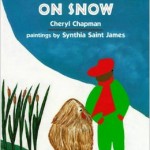


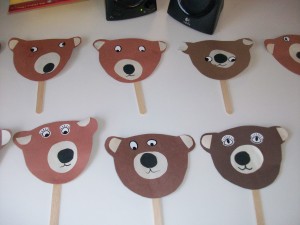
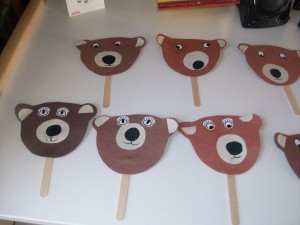
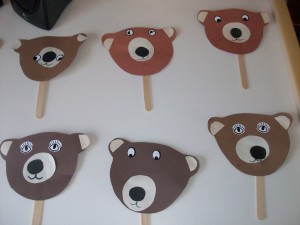
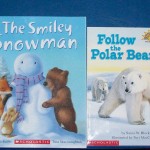
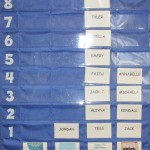
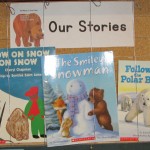

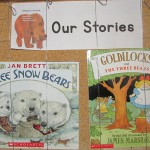
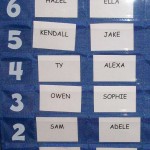
4 Responses to “Where Are Her Eyes?”